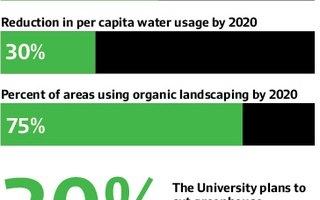{shortcode-ed440969e41c3812658f44a31a67a0f22b7f0f86}
UPDATED: April 27, 2018 at 1:42 a.m.
Harvard continued to reduce trash production per capita and water use in 2017, bringing the University closer to reaching its sustainability goals, according the 2017 Sustainability Report released Wednesday.
The report—which detailed the University’s progress toward its Sustainability Plan benchmarks set in 2014 for completion by 2020—shows that Harvard has reduced its trash production per capita by 44 percent from a 2006 baseline, a 1 percent improvement over the past year. The school has reduced its water use by 26 percent compared with the baseline, a 2 percent reduction in use over the past year.
Carbon emissions held steady in 2017 at the 30 percent reduction achieved last year over the total time period of the campaign. This overall reduction has continued despite an increase in campus square footage and the addition of spaces that consume significant energy like laboratories.
Heather A. Henriksen, director of the Office for Sustainability, wrote in a letter announcing the report that cross-disciplinary work is necessary to address global climate concerns and that the University’s “One Harvard” campaign is conducive to this goal.
“Harvard is perfectly positioned to contribute to in helping to define a path forward, not only through our cutting-edge research but also by using our campus as a living lab for testing promising new solutions that will build stronger, more resilient communities,” she wrote.
This year’s report features new graphic tools, which form part of an effort to allow University affiliates to track progress and to make data sets available for study and benchmarking, according to Henriksen.
“To strengthen our commitment to transparency, evaluation, and accountability we have added new interactive charts to this year’s Report which are aggregated in an exciting new online data dashboard that will allow you to view our progress in more detail,” Henriksen wrote.
One graphic specifically shows that, while campus housing accounts for 31 percent of campus space, residential buildings use only 16 percent of total energy. Labs, by contrast, account for 22 percent of building space and use nearly half of all energy consumed on campus.
Other graphics show that public transit and walking are the most common commuter methods for Harvard affiliates, and that the University has seen a decrease in the number of campus vehicles running on gas.
In addition to these measures, in 2017 Harvard's Chief Information Officer Council approved sustainability standards for information technology that apply across the University.
Beyond efficiency and waste reduction, the sustainability initiatives aim to integrate study of climate change into the University’s curriculums. All 900 first-year students at the Business School examined how climate change would impact business for the first time in 2017, according to the report, and some first-year students in Harvard’s new Master in Design Engineering program focused on sustainability projects.
University President Drew G. Faust introduced the University’s new Climate Action Plan in February, including plans for the University to become fossil fuel-neutral by 2026.
This article has been revised to reflect the following correction:
CORRECTION: April 27, 2018
A previous version of this article incorrectly indicated that the University earned a federal Chief Information Officer Council designation for sustainable information technology practices in 2017. In fact, in 2017 Harvard's Chief Information Officer Council approved sustainability standards for information technology that apply across the University.
—Staff writer Jamie D. Halper can be reached at jamie.halper@thecrimson.com. Follow her on Twitter @jamiedhalper.
Read more in News
Brown-Nagin Named Radcliffe DeanRecommended Articles
-
 University Sets New Goals for Curbing Consumption, Waste
University Sets New Goals for Curbing Consumption, Waste -
Scientist Discusses Health, Campus SustainabilityArlene D. Blum discussed her work to reduce use of what she called harmful flame retardant chemicals in consumer products, which she praised Harvard for moving away from in recent years.
-
 Sustainability Office Relocates to Harvard Square
Sustainability Office Relocates to Harvard Square -
 New 'Living Laboratory' Initiatives to Increase Sustainability Funding
New 'Living Laboratory' Initiatives to Increase Sustainability Funding -
 Univ. Endowment Fell Behind National Average, Report Finds
Univ. Endowment Fell Behind National Average, Report Finds













